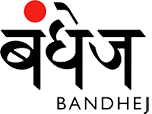
HANDCRAFTED, Sustainable Fashion
Currency

Moving to AJRAKHPUR
Most block printing centres developed near rivers as flowing water is a very important for dyeing fabrics. Dhamadka was close to the river Saran Ganga, which dried up in the early 1990s and it was getting difficult to continue printing without a regular source of flowing water. They dug wells, but the high iron content in the bore well water made it unsuitable for dyeing, as it was impossible to achieve the desired brightness in colour. With new industries coming up within their vicinity, the water table was going down rapidly, forcing them to dig deeper. A group of printers had started discussing the possibility of moving to a new location where they could find ample flowing water, preferably close to the city, as better connectivity would also help their business.
The earthquake of 2001 destroyed of many homes and printing sheds and 105 people lost their lives. This accelerated the process of moving to a new location. The group decided to look for around 75 acres of land to help them relocate. Everyone had great faith in Mohammadbhai Siddikbhai’s family, so Ismail was the logical choice to lead them, and a committee of 11 people was formed, to take the scheme forward. The basic norms and requirements for the land were discussed and agreed upon: the availability of around 75 acres with a clear title at a reasonable price, compatible neighbouring communities and proximity to a town, preferably Bhuj. The quality of the water would be checked using traditional methods, to make sure that it was suitable. Harade (terninalia chebula, mordant) would be mixed with the water sample, and if its iron content was high the water would turn black.)

An Ahir farmer of Paddhar village, only 13 km from Bhuj offered them 50 acres of land that fulfilled all their requirements. The communities living around this area were Hindus, but they had no problem with the Muslim Khatri families moving there as their neighbours. The government was not willing to help as Dhamadka was in Anjar taluka, and the new site that had been selected was in Bhuj taluka. The printers of Dhamadka decided to invest their own money to buy the land, so that they could resettle and start afresh. The land cost them Rs. 60 per square metre, and by selling plots the committee earned some
Rs. 21,00,000, which was invested in developing the basic infrastructure, most importantly the multilevel tanks to stimulate the flow of the running river water as a common washing facility for all the printers to use in Ajrakhpur.
In the past, many printers were using naphthol dyes. This offered a range of wonderful deep shades, especially in the reds family. After a few dyers were ill with cancer, and many felt that the toxic naphthol dyes could be one of the reason of this illness so collectively all printers have decided to shift to using only natural dyes that are good for their own health and the health of their environment. This has now become their marketing USP, selling eco-friendly block printed fabrics.

The people of Ajrakhpur are determined to build an ideal village that is self-sufficient. They have collectively decided to use only vegetable dyes or the new eco-friendly dyes. They are trying to create a clean and green environment with proper roads and by-lanes, an effluent plant, a common washing facility for the community, and a water-treatment plant to recycle water.










